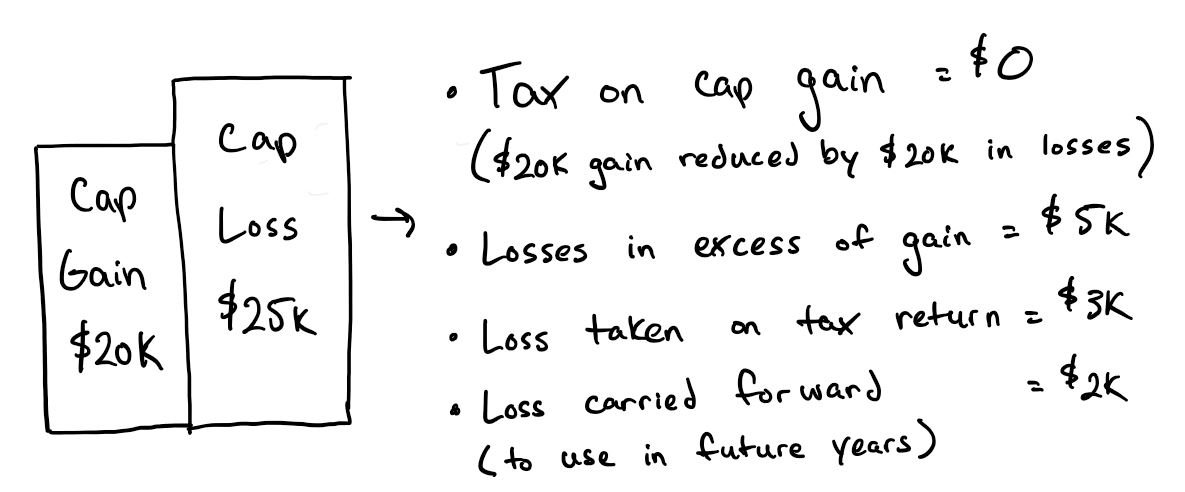Tax-Loss Harvesting
We’re heading into the year-end holiday season, which means it’s time to start considering tax-loss harvesting
It has been a rough year for the stock market. Diversified indexes like the S&P 500 or Nasdaq are down 18-30%, tech favorites like Amazon and Netflix are down 40-60%, and Crypto like Bitcoin or ETH are both down over 60%
While portfolios are down, the silver lining is that this represents a great tax opportunity for those that can take advantage.
First, the basics: How do capital gains & losses work?
A capital gain or loss occurs when you sell an investment, which can be a stock, a bond, or even a house.
You’ll hear the term “realized” - this just means you’ve actually sold the investment. Generally, you’re not taxed on “unrealized” gains (meaning things you haven’t sold).
The capital gain/loss will be classified as either long- or short-term:
Short-term is when you’ve bought and sold the asset within 1 year
Long-term is when you’ve owned the asset for longer than 1 year
Note these aren’t tied to the calendar year, just 365 days from the date of purchase to determine the type of gain/loss
Example of how to determine long- vs short-term
Short- and Long-term capital gains are also taxed differently:
Short-term capital gains are taxed at your ordinary tax rate, so there’s no preferential tax treatment
Long-term capital gains are taxed at a preferred lower rate. You ideally want long-term rather than short-term capital gains.
At the end of the year we net out your capital gains and losses. This is the key component of tax-loss harvesting:
Short-term capital losses first offset short-term capital gains
Long-term capital losses first offset long-term capital gains
Any excess losses in either category can then be applied to the other gain type.
After offsetting all of your capital gains, you can use up to $3,000 of capital losses per year to further reduce your ordinary income. If you still have capital losses beyond the $3k, we carry them forward indefinitely until they’re used up.
An example of how a net capital gain is taxed:
On January 1st you purchase $10k of Amazon stock and $10k of Exxon Mobil stock.
On November 15th you sell your Amazon stock for $4k and your Exxon Mobil stock for $17k.
You now have a realized capital loss of $6K from Amazon, and a realized capital gain of $7k from Exxon Mobil.
Both of these are short-term (bought & sold within 1 year)
They’ll net each other out on your tax return, so you’ll have $1k of short-term capital gains to pay tax on at your ordinary tax rate.
An example of how a net capital loss is taxed:
What is tax-loss harvesting?
Simply put, tax-loss harvesting is the process of selling investments at a loss to reduce taxes on gains from other investments.
You’re purposefully realizing investment losses to offset other capital gains you realized during the year.
Tax-loss harvesting sounds great in principle, but what if you didn’t want to sell the investment at a loss because you believe in it long term? Well, you can sell it (to realize the loss) and then rebuy it (to regain exposure to the investment).
However! There are some important “gotchas” with this approach, called the Wash Sale Rule.
Wash Sale Rule
The wash sale rule states that if you sell a stock at a loss and buy the same stock or a “substantially identical” stock within 30 days before or after, you cannot recognize that loss. Here’s how it applies to different types of investments:
Individual Stocks
Strictly speaking, you can’t avoid the wash sale rule on stocks. If you sell a specific stock at a loss then you must wait at least 30 calendar days to rebuy it, otherwise the loss won’t count.
ETFs/Index Funds/Mutual Funds
This is where it gets interesting. Similar to stocks, you can’t sell and rebuy the same ticker otherwise you’ll create a wash sale.
However, you could sell out of one S&P 500 mutual fund, and immediately rebuy a different S&P 500 ETF. This is where things get a bit more complex, and you may need to consult your wealth advisor, but the diagram below gives you some examples of what’s possible
Source: Blackrock - Tax Loss Harvesting at a Glance
Cryptocurrency
Avoiding the wash sale rule with crypto is simple: as of December 2022 wash sales don’t apply to crypto.
So you can sell Bitcoin (BTC) at a loss and immediately rebuy Bitcoin (BTC) to capture the loss.
Key Takeaways:
You can avoid tax on your capital gains by selling other investments at a loss in the same calendar year.
You can even maintain exposure to the same investments you’re selling, but you need to navigate the wash sale rules.




